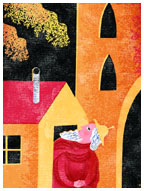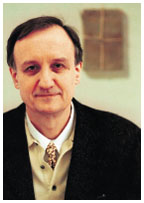February 9, 2005: Features
James O'Brien |
A
guide to Righteous living
Professor Peter Schaefer brings a medieval Jewish manuscript
to life
By Kathryn Levy Feldman ’78
Reuben, a member of a pious Jewish sect living in the German city of Mainz during the 12th century, faced a conundrum. Every time he left the confines of his narrow house, which was located directly next door to the town’s imposing cathedral, he had to duck his head to avoid hitting it on the doorframe. He was concerned that observers might misconstrue his action as bowing his head to the church. What was the proper way to exit his dwelling? Judah, his neighbor, faced a similar dilemma. Just one day earlier he had seen the most beautiful flowering apple tree, and he wanted to offer a blessing of thanksgiving to God for creating something so magnificent. But the tree was located in the courtyard of the cathedral. Should he still recite the customary blessing?
These were some of the questions that faced the sizable community of German Jews who lived in cities along the Rhine from 1150 to 1250 and were known as Hasidim (devout) Ashkenazim (Jews from Central and Eastern Europe). Religious and cultural leaders of Ashkenazi Judaism settled in cities such as Mainz, Speyer, and Worms, where they recorded their influential views on ethical theory and practice.
Photo: Courtesy Peter Schaefer |
Peter Schaefer, Princeton’s first Ronald O. Perelman Professor of Jewish Studies, is working on a multiyear project to compile and translate one of the most significant of these manuscripts, the Sefer Hasidim, or Book of the Pious. Known as one of the most important sources for the religion, history, and culture of medieval German Jewry, the text is presented as a guidebook for the practice of Jewish piety as conceived by 12th-century Hasidim, and consists mostly of parables, homilies, and exempla that appeal to the everyday experiences of its author (or authors) and audience.
Thus, according to the Sefer Hasidim, our fictitious Reuben should turn sideways or backwards before he ducks his head, and Judah should recite his blessing on the next flowering tree he sees that is not located on church property.
“The book is a major source for how Christians and Jews lived together in medieval Germany,” the German-born Schaefer explains. There is currently no edition that integrates all the Hebrew manuscripts into a single volume, and there is no translation of the entire text in any modern language. With help from students, Schaefer is directing a two-pronged effort: first, the compilation of a critical edition of the Hebrew manuscripts; and second, the creation of a full, annotated English translation.
Schaefer hopes that the single Hebrew volume will serve as a reliable edition for further study of the heretofore-overlooked manuscript, and that the translation will make the text accessible to a broad range of scholars. “Sefer Hasidim is a fantastically important source for the history of medieval Jewry in Germany,” explains Anthony Grafton, the Henry Putnam University Professor of History and chairman of the Council of the Humanities. “The tales themselves are very rich, and they indirectly show us all kinds of rituals and beliefs, ways of dealing with children and spouses, views of women and non-Jews, burial customs — in action. A whole lost social world is preserved here, not as prescribed by rabbis but, to a considerable extent, as people actually lived.”
There is, for example, the practical matter of the Jewish custom of prompt burial of the dead. The Sefer Hasidim instructs that those who sell shrouds should not delay burial of the dead while waiting for payment; instead, every community should appoint a trusted person to be in charge of purchasing the shrouds and burial services, who later would collect expenses from the heirs. The custom of visiting gravesites is enforced by the tale of a community that wanted to move to a new location. According to the Sefer Hasidim, one of their dead appeared in someone’s dream and warned against relocation. “Don’t leave us. We enjoy it when you come to the cemetery. You should know that if you leave us, you will be killed,” is the working translation of the warning. Alas, according to the tale, the community members did not heed the advice and they were all killed.
The text also is important because of its effect on Jewish culture in medieval Europe and beyond. Widely circulated, the manuscript influenced the distinctive religious practices and Hebrew literary style of Jews in Germany. In addition, the radically new approach to ethical theory and practice, as articulated in the Sefer Hasidim, went beyond the laws laid upon the righteous in the Bible and Talmud. The book is filled with precepts not found in earlier tradition (such as a renewed interest in ascetic practices, a system of penitence for sin, and a focus on the individual’s quest for self-
perfection), many of which put its followers in conflict with the community at large. “These Jews believed they were better than their fellow Jews,” says Schaefer. “Very often their enemies were not Christians, but other Jews.”
In fact, as the Sefer Hasidim indicates, 12th-century German Jews and their Christian neighbors managed to live together in relative harmony. The book preserves an often-poignant snapshot of a pivotal stage in the history of Jewish-Christian relations in Europe, before the progressive imposition of social and political isolation on the Jewish people that culminated in the Holocaust. Researchers working on the Sefer Hasidim project are attempting to “make the voices of the 12th- and 13th-century Rhineland Jewish communities more accessible to the modern world,” notes Kevin Osterloh, a doctoral candidate who serves as liaison between Schaefer and the undergraduate transcription team.
Rena Lauer ’05, a history major from West Orange, N.J., is one of the undergraduates on the transcription team. Chosen for her exceptional Hebrew language skills, Lauer transcribes handwritten Hebrew script from the manuscript into a Word document on her computer. She must first decipher the scribe’s handwriting, abbreviations, and editorial style, she explains, adding, “It’s all like a big puzzle — which is fun!”
Lauer often finds herself on the same literal and figurative page as “her” scribe. “Working with the original layout sucks you in, makes you feel a little like you’re there,” she continues. “You really get into the head of the scribe in an unexpected way. You get used to his particular style. I can tell when something was off — maybe he was tired or his kids were bothering him, who knows? — but you can really perceive a person in there.”
Sometimes Lauer finds the material “quirky,” which can add to its accessibility. Even the section called “Nashim” (women), in which the topic is primarily marriage and the perspective is decidedly different from our modern sensibilities, has its humorous moments. “I was transcribing a section about engagements, and the rule sounded less like a rule and more like something out of a Henny Youngman routine,” she explains. “It started something like this: ‘An old man and a young man make an agreement to marry two sisters, one pretty and one ugly one.’ Doesn’t that sound like something from the ’50s Borscht Belt, not the 12th or 13th centuries?”
Other stories answer such questions as: Are Jews permitted to read Christian books? (If you go on a trip with a donkey, put the Jewish books on one side and the Christian books on the other.) Are Jews allowed to teach monks about Judaism if they show curiosity? (No, the monks might intentionally or unintentionally “borrow” the Jewish prayers and use them to praise the Christian God.) Are Jews permitted to do business with Christians? (Yes, but never to cheat them.) “The rules in Sefer Hasidim are all about setting up boundaries between Jews and their Christian neighbors in everyday interactions,” Schaefer says. “To a certain extent, the Jews wanted to know how far they could go.”
Which is also a question the non-Jewish, 61-year-old Schaefer asked himself when he was a student of Christian theology in the early 1960s. “I did not like the way Hebrew was being taught at the time in Germany,” the 6-foot-tall, slender professor says. “I wanted to learn Hebrew as a spoken language, to be able to read classical sources, and also to be in touch with an environment in which Judaism was alive and not a rarity.” And so, in 1964, he went to Israel, where he was one of the country’s first German students, and spent two years at Hebrew University in Jerusalem becoming fluent in Hebrew.
Schaefer returned to Germany to receive his Ph.D. from the University of Freiburg. In 1984, he was appointed chairman in Jewish studies and director of the Institute of Jewish Studies at the Free University of Berlin, the city’s post-communist university. Internationally regarded as one of the finest scholars in Jewish studies and the 1994 recipient of Germany’s Leibniz Prize, granted to that nation’s most innovative scholars, Schaefer was a member of the Institute for Advanced Study in Princeton for three years before coming to the University in 1998. He has written numerous books, including Mirror of His Beauty: Feminine Images of God from the Bible to the Early Kabbalah (2002), and has edited the Jewish Studies Quarterly since 1993. For the future, he plans a translation of the Toleot Yeshu (history of Jesus), which he describes as a “Jewish counter-narrative of the New Testament.”
Schaefer and others on the Sefer Hasidim team hope that the project
not only will establish Princeton’s Perelman Institute for Jewish
Studies as a leading center for the study of a great civilization, but
also will help to make it an integral part of academic life at the University.
“The result, we hope, is for a renewed debate on the great significance
of this time period for Jewish history and Jewish-Christian relations,”
Osterloh, the doctoral canditate, says, “and ultimately for a more
informed discussion of our ongoing relationship with the past.”
![]()
Kathryn Levy Feldman ’78 is a frequent PAW contributor.



